A spring house offers you a natural, energy-efficient way to preserve food using cool spring water and strategic design principles. You'll need to maintain temperatures between 35-40°F and humidity levels of 75-95% RH for ideal storage conditions. Position your storage areas strategically, with dairy products on lower shelves and root vegetables in ventilated containers layered with sand or sawdust. Install wireless sensors to monitor conditions, and guarantee proper air circulation through strategic vent placement. Regular cleaning and maintenance of your spring house will prevent contamination and extend food shelf life. Our extensive guide will equip you with centuries-old wisdom merged with modern preservation techniques.
Historical Spring House Design
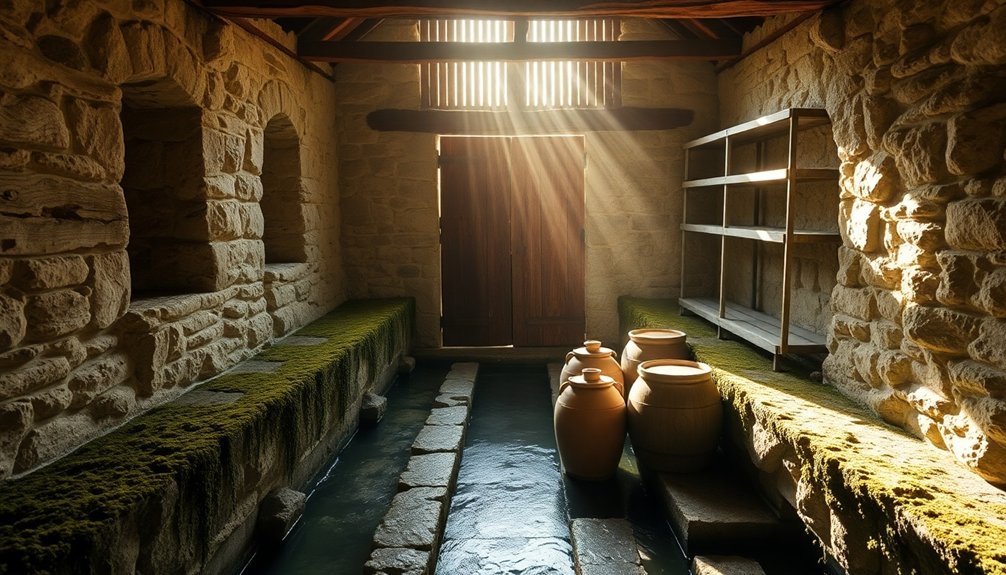
If you're examining a traditional spring house, you'll notice how they're thoughtfully integrated into the farm's layout, positioned to guarantee water purity for both household and livestock needs.
The stone water troughs provided a continuous flow of fresh spring water to maintain cool temperatures year-round.
The structure's design often included separate areas for specific tasks like butter churning and cheese making, while some featured fireplaces for laundry work or other household chores.
Natural Water Cooling Systems
Building upon the traditional spring house design, modern natural water cooling systems offer enhanced efficiency while maintaining the same core principles. You'll find these systems utilize influent and effluent pipelines to transport cold source water, with heat exchangers managing the thermal transfer process. The ideal temperature difference between incoming and outgoing water should be around +5ºC.
These systems provide significant benefits through reduced operational costs and environmental impact. District cooling plants achieve higher cooling efficiency through natural cold-water sources. You'll save on daily expenses while conserving resources and minimizing chemical usage.
| Component | Function |
|---|---|
| Influent Pipeline | Carries cold source water to facility |
| Heat Exchangers | Transfers heat between system and source water |
| Effluent Pipeline | Returns warmed water to source |
| Pumps | Circulates water through system |
| Additional Components | Includes compressors and thermal insulation |
When implementing a natural water cooling system, you'll need to position your facility near a cold-water source. The design must account for ideal pipeline depths to maintain desired water temperatures. While the initial setup requires careful planning, you'll benefit from lower operational costs, reduced chemical usage, and improved environmental sustainability over traditional cooling methods.
Temperature Control Fundamentals

Temperature control mastery forms the backbone of effective spring house cold storage operations.
You'll need to implement a thorough monitoring system using wireless sensors throughout your facility to track temperature and humidity levels continuously. These sensors transmit data to a central system that'll alert you when conditions deviate from acceptable ranges.
You must maintain specific temperature zones for different products. Store your vegetables at 55°F, dairy products at 34°F, and keep frozen items at 0°F or below. Implementing insulated curtain walls helps maintain distinct temperature zones effectively.
Install temperature controllers or thermostats that'll automatically activate cooling systems when readings move outside preset parameters.
To guarantee your system's effectiveness, you'll need to follow key operational practices. Implement a FIFO system to rotate stock properly, and maintain detailed temperature logs to track performance.
Don't keep storage doors open longer than necessary, as this creates unwanted temperature fluctuations. Place absorbent materials under meat products to manage potential drips, and designate specific storage zones for different items.
Remember to calibrate your monitoring equipment regularly and schedule routine maintenance to maintain system accuracy and reliability.
Dairy Storage Best Practices
Proper dairy storage demands unwavering attention to temperature precision and organization. You'll need to maintain your spring house cold storage at 2°C to 4°C (36° to 39°F) to prevent spoilage and extend shelf life.
Keep your dairy products in the back of the lower shelf, where temperatures remain most stable, and away from direct sunlight or heat sources.
You'll want to use airtight containers for all your dairy items to preserve freshness and prevent odor absorption from other foods. Don't store dairy products near strong-smelling items, and create a dedicated storage section in your spring house specifically for dairy.
When you're storing milk long-term, use plastic containers with expansion room if freezing is necessary.
Maintain cleanliness by regularly sanitizing your storage area and implementing a strict rotation system. Label everything with dates, and always use older products first.
Don't overstock; instead, follow a consistent delivery schedule that matches your consumption patterns. When handling dairy products, return them to cold storage immediately after use, and keep the door closed to maintain stable temperatures.
Regular temperature monitoring and proper organization will greatly extend your dairy products' shelf life.
Root Vegetable Preservation Methods
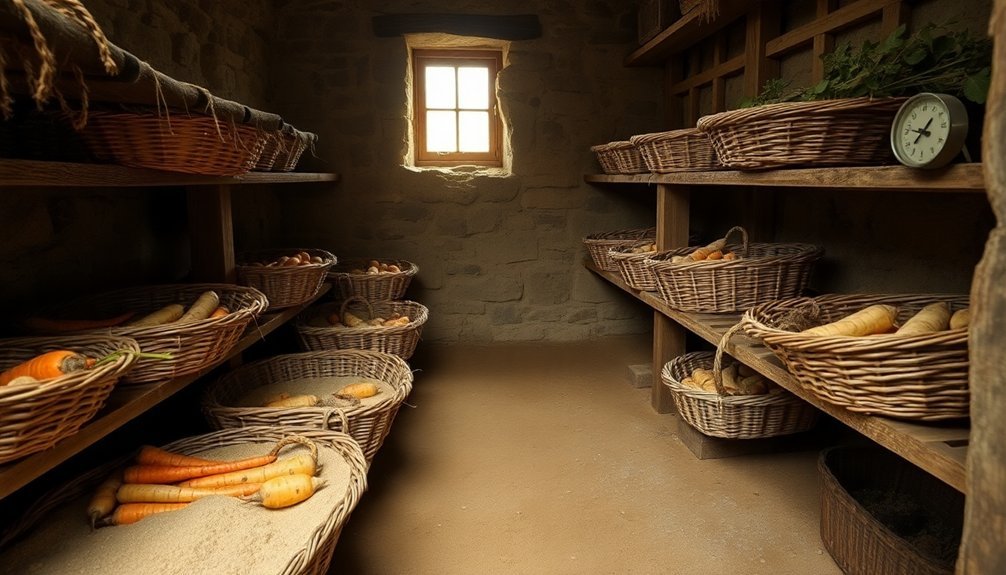
In your spring house, root vegetable preservation requires a careful balance of humidity, temperature, and storage methods. You'll need to focus on maintaining temperatures between 35° and 40°F while ensuring proper ventilation to prevent spoilage.
Begin by selecting unblemished vegetables and avoid washing them before storage.
For long-term storage, you've got several effective options. Layer your root vegetables in clean sand or slightly damp sawdust, making sure they don't touch each other. You can use wooden crates or plastic bins with ventilation holes.
If you're storing potatoes, keep them in dark conditions to prevent sprouting. For onions and garlic, cure them in sunlight first, then store them in mesh bags or shallow boxes with good air circulation.
Consider creating a root cellar pit within your spring house by digging a hole and layering vegetables with straw or leaves. You'll want to cover this with soil and a waterproof material.
For smaller quantities, try the clamp storage method by creating an insulated mound using straw and soil. Remember to check your stored vegetables regularly, removing any that show signs of spoilage to prevent spread.
Humidity Management Techniques
You'll need to understand both mechanical and natural humidity control systems to maintain ideal storage conditions for your produce.
In a spring house setup, you can install automated moisture control systems that monitor and adjust humidity levels through sensors and water sprays, keeping your storage at the perfect 95% RH for cold storage or 75% RH for warmer conditions.
To enhance humidity naturally, you can also place water-filled containers strategically throughout your storage space or use moisture-retaining materials like straw or sawdust on the floor.
Moisture Control Systems Explained
Moisture control stands as the cornerstone of effective cold storage management. You'll find that traditional solutions like strip curtains aren't enough to address the root causes of humidity issues. Instead, you need thorough dehumidification systems that target moisture at its source while delivering dry, controlled air throughout your storage space.
For ideal moisture control in your spring house cold storage, you'll want to take into account these essential components:
- Desiccant dehumidification systems that capture moisture and maintain low dew points
- Customized placement options, either inside or outside your facility, based on your specific layout
- Strategic air distribution systems that guarantee uniform humidity control
- Rapid-action doors and proper insulation to prevent moisture infiltration
- Enhanced evaporator temperatures to minimize condensation risks
You can greatly improve your storage efficiency by implementing these moisture control systems. They'll help you avoid costly problems like ice formation, water damage, and product spoilage.
Beyond preservation, you'll benefit from reduced maintenance needs, lower energy costs, and fewer operational disruptions. Remember, controlling moisture at its source provides better ROI than constantly addressing symptoms after they appear.
Natural Humidity Enhancement Methods
Through careful management of natural humidity levels, your spring house cold storage can maintain ideal product freshness without relying solely on mechanical systems.
You'll need to focus on maintaining humidity levels between 75-95% RH, depending on your stored products, with most fruits and vegetables requiring around 95% RH just above freezing.
You can enhance natural humidity by implementing perforated polyethylene barrier films around your produce. These films create a microclimate that maintains atmospheric humidity between 94-98%, greatly reducing moisture loss.
Consider using evaporative media techniques, which don't require complex mechanical systems but still effectively raise humidity levels.
To maximize natural humidity control, you'll want to minimize ventilation while still maintaining necessary air circulation. You can achieve this by strategically placing water-containing vessels in your storage area or using simple misting techniques, being careful to avoid direct spray on produce.
Remember that your cooling process can lower humidity levels, so you'll need to balance temperature control with moisture retention. You can monitor condensation patterns to adjust your approach, as excess moisture can be just as harmful as insufficient humidity.
Air Circulation Requirements
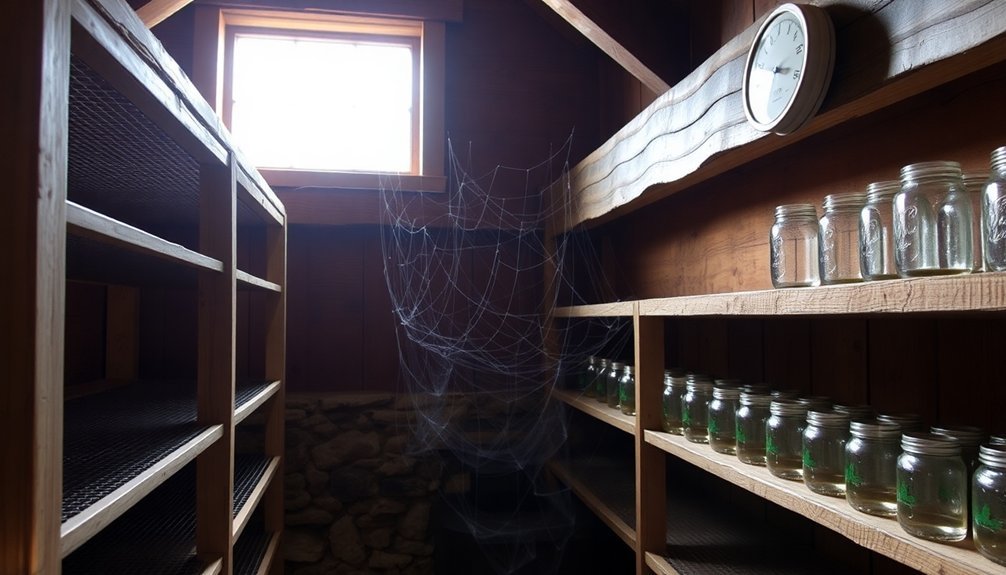
Your spring house cold storage needs proper ventilation setup to maintain consistent temperatures and prevent spoilage.
You'll want to position vents strategically, with cold air inlets near the floor and warm air outlets near the ceiling to create a natural circulation pattern.
Installing adjustable dampers and appropriate fans will let you control airflow based on seasonal changes and the specific requirements of your stored items.
Ventilation System Setup
A well-designed ventilation system serves as the cornerstone of an effective spring house cold storage setup. You'll need to carefully position multiple vents, typically 3-4 inches in diameter, near entrances and low to the ground to guarantee proper air exchange.
Install core drilled holes in block walls for ideal ventilation while maintaining airtight sealing with proper airlocks to minimize unnecessary air loss.
Your ventilation system should include a combination of equipment to achieve specific functions:
- Install air curtains at entry points to prevent temperature fluctuations and block contaminants
- Use axial fans for general air circulation throughout larger storage areas
- Place centrifugal fans in areas requiring high-pressure applications and filtration
- Position exhaust fans strategically to remove warm air and excess humidity
- Consider evaporative coolers for additional cooling in dry climate conditions
Confirm your ducts are properly routed to bring in clean air and expel stale air effectively.
You'll need to maintain consistent temperatures while managing humidity levels. Regular monitoring of temperature and humidity sensors, along with weekly inspections for moisture and proper airflow, will help prevent mold growth and maintain ideal storage conditions.
Air Flow Pattern Design
Building on proper ventilation setup, effective airflow patterns serve as the foundation for maintaining consistent temperatures throughout your spring house. You'll need to guarantee cold air circulates from the ceiling downward, reaching all storage areas uniformly. Position your vents strategically to prevent cold air from pooling at the bottom and creating unwanted temperature variations.
When designing your airflow pattern, consider these critical factors:
| Air Direction | Purpose | Implementation |
|---|---|---|
| Top to Bottom | Even distribution | Install ceiling-mounted cooling units |
| Front to Back | Complete coverage | Place vents at strategic intervals |
| Side to Side | Cross-ventilation | Add lateral fans for circulation |
| Corner Areas | Eliminate dead spots | Install corner air movers |
| Product Zones | Targeted cooling | Create dedicated circulation paths |
Stack your products with adequate spacing between items and walls to allow free air movement. You'll want to maintain higher air changes per hour (ACH) for perishable items and implement forced-air cooling methods where necessary. Use CFD simulations to identify potential hotspots and optimize your circulation system. Remember to keep fans clean and well-maintained to guarantee consistent airflow patterns throughout your storage space.
Construction and Materials
Through careful selection of materials and precise construction methods, spring house storage systems require specific components to secure lasting durability.
You'll need to start by excavating a 4-foot deep rectangular area that's large enough for two rooms, typically 6 by 8 feet, along with a refrigeration trench that's 2 1/2 feet wide and 2 feet deep.
Essential materials for your spring house construction include:
- 1-by-4-inch boards for perimeter framing
- Concrete reinforced with rebar for floors and walls
- PVC piping for water flow management
- Concrete blocks for retaining walls and interior shelving
- Plywood and scrap lumber for trench boxes
You'll want to build a 6- to 8-inch retaining wall around the spring to keep out debris, and install proper steps leading down to the spring room.
Between the spring room and food refrigeration area, you'll need to construct a door for easy access. The concrete must be thoroughly smoothed and allowed to dry completely to prevent future cracking.
Don't forget to incorporate reinforcing bars throughout the concrete structures to secure maximum strength and longevity.
Seasonal Maintenance Tips
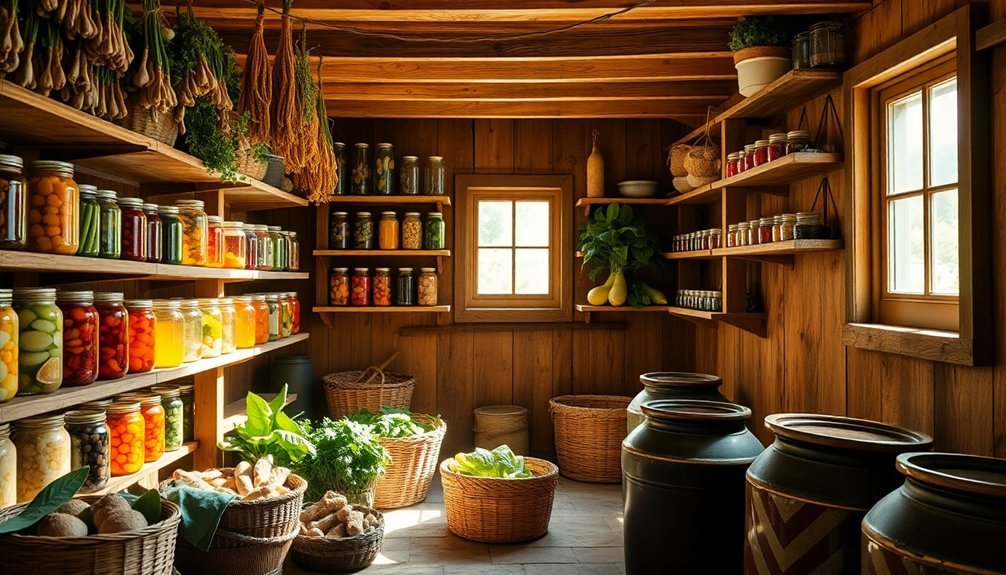
Your spring cold storage maintenance starts with thoroughly checking all equipment, including compressors, evaporators, and ventilation systems for peak performance.
You'll need to monitor and adjust temperature settings throughout the year as outdoor conditions change, ensuring your storage space maintains consistent cooling levels between 32-40°F.
Set up a weekly cleaning schedule to wipe down shelves, walls, and floors while checking for any signs of mold or moisture buildup that could compromise your stored items.
Pre-Season Equipment Inspection
Proper pre-season equipment inspection serves as the foundation for reliable cold storage operations throughout the year. To guarantee your cold storage system operates at peak efficiency, you'll need to thoroughly examine all components before the busy season begins.
Start with an extensive cleaning of your equipment. You should pressure wash the interior and exterior surfaces to remove any built-up debris, using mild detergent and clean water where appropriate. Don't forget to disconnect power cords before cleaning electrical components.
- Inspect all mechanical parts, including belts and chains, confirming proper adjustment and tension.
- Check the hydraulic system thoroughly for leaks, cracks, or worn hoses.
- Examine electrical wire harnesses and connections for signs of wear, abrasion, or corrosion.
- Test the refrigeration system's functionality and address any performance issues immediately.
- Apply dielectric grease to electrical connections to prevent corrosion and guarantee reliable operation.
Remember to document your inspection findings and address any issues promptly.
After completing repairs or maintenance, perform a final function check of all systems and accessories. Regular inspections help prevent unexpected breakdowns and extend your equipment's lifespan while maintaining ideal cold storage conditions.
Temperature Control Year-Round
Maintaining consistent temperatures in your spring house throughout the year requires careful attention to seasonal changes and specific maintenance routines.
During spring, you'll need to inspect your insulation carefully, checking walls, ceilings, and doors for any wear or damage. Clean your condenser coils to remove winter debris and guarantee they're operating efficiently.
As summer approaches, monitor ambient temperatures closely and adjust your cooling methods accordingly. You'll want to optimize your cooling system by using automated vents when outdoor temperatures permit and guaranteeing your air conditioners are properly mounted on exterior walls.
Keep an eye on refrigeration inlet and outlet temperatures, and check fluid pressures regularly.
Don't forget to test your temperature controls throughout both seasons. Make sure your thermostats are calibrated correctly and set up trigger alarms for any unauthorized entries or temperature deviations.
You'll need to inspect door seals frequently, replacing any that show signs of wear or damage. Remember to maintain clear access paths and prevent condensation issues by properly sealing equipment and using machinery designed for low-temperature environments.
Cleaning And Sanitizing Schedule
A well-structured cleaning schedule forms the backbone of spring house maintenance throughout the year.
You'll need to perform thorough cleaning and disinfection at least annually, with seasonal deep cleans at the start of each harvest period. Monthly checks of alarms, internal temperatures, and power supplies are essential components of your regular maintenance routine.
For effective cleaning and sanitizing, follow these key protocols:
- Use water under 30°C with neutral pH soap solutions when needed, avoiding harsh chemicals like acetone, ammonia, or abrasive cleaners.
- Clean surfaces thoroughly with appropriate detergents before sanitizing to remove dirt and grease.
- Apply sanitizers according to label instructions, ensuring proper concentration and application methods.
- Allow surfaces to air dry completely after sanitizing.
- Document all cleaning and sanitizing activities, including dates and methods used.
Don't forget to inspect equipment regularly for repairs and maintenance needs.
Check door seals, gaskets, and HVAC systems, particularly before seasonal changes. If you're using a pressure washer, keep it below 5 bar to protect surfaces.
For enhanced preservation, consider using ozone as an antimicrobial agent to extend food product shelf life and eliminate bacteria.
Food Safety Guidelines
Safe food storage begins with rigorous temperature control in your spring house's cooling and freezing zones.
You'll need to maintain cooler temperatures between 35-38 degrees Fahrenheit to keep foods at 41 degrees or below, while freezer temperatures should stay between 0 to -10 degrees to keep items frozen solid.
Monitor your storage zones at least twice daily using calibrated thermometers and keep detailed temperature logs.
Don't let foods linger in the danger zone (68-113°F), as this promotes bacterial growth.
You'll want to cool foods to below 8°C within 90 minutes of preparation.
Store your items strategically to prevent cross-contamination.
Keep raw foods below cooked items, and don't overstock your coolers – proper airflow is essential.
Use covered containers and organize produce, dairy, ready-to-eat foods, meats, and condiments in designated areas.
Never refreeze thawed foods, as this can lead to foodborne illness.
Check use-by dates regularly and discard questionable items.
Clean your storage areas frequently, including shelves, walls, and floors.
Defrost your freezer periodically to maintain efficient operation and guarantee temperatures remain consistent throughout all storage zones.
Spring Water Flow Engineering
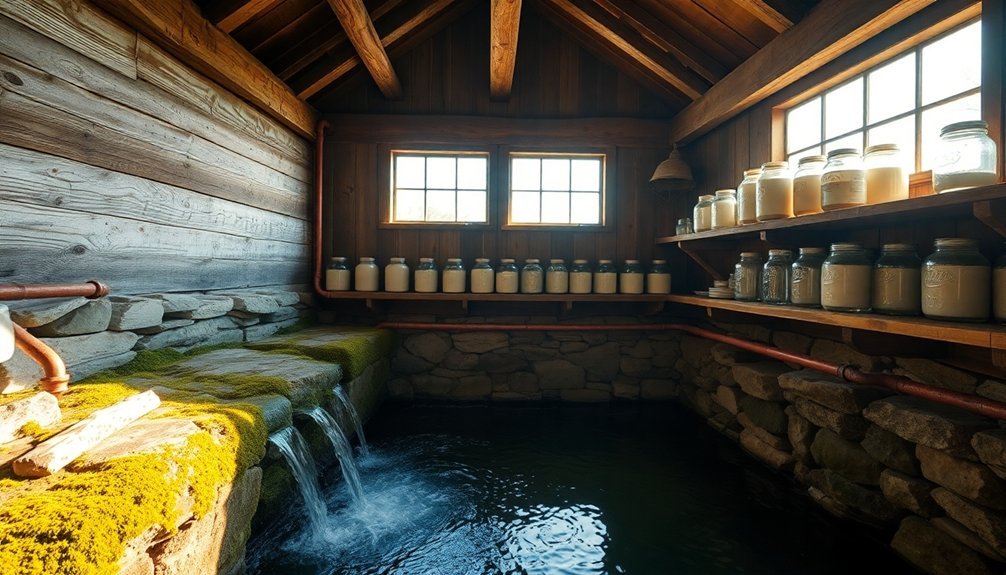
Successful spring water flow engineering relies on two core development methods – concentrated spring and seepage spring systems.
For concentrated springs, you'll need to excavate upslope until you find adequate water flow, then install a rock bed and collecting wall.
With seepage springs, you'll dig test holes to locate the impervious layer and create a trench with collection tile surrounded by gravel.
Your spring box design is vital for both methods. Build it at least 4 feet deep with concrete, and guarantee it has a watertight cover. You'll need both overflow and outlet pipes for proper drainage and cleaning.
- Install collection pipes in gravel-lined trenches to filter sediment
- Build a concrete cutoff wall to prevent downslope water loss
- Position the spring box inlet below the collector tile elevation
- Protect the system from freezing conditions
- Monitor flow rates throughout the year, especially during dry seasons
For peak performance, you'll want to implement a gravity-flow system whenever possible. This guarantees reliable water movement while requiring minimal maintenance.
Don't forget to divert surface water away from your spring box and maintain a contamination-free zone around the collection area.
Frequently Asked Questions
How Do Fish Ponds Integrate With Spring House Cooling Systems?
You can connect your fish pond to a spring house cooling system by circulating warm pond water through cooling channels, using natural spring water's temperature to maintain ideal conditions for your fish.
Can Spring Houses Effectively Preserve Modern Packaged and Processed Foods?
You shouldn't rely on spring houses for modern packaged foods. They're not designed to maintain the specific temperatures and sterile conditions that processed foods require. Instead, use proper refrigeration or recommended storage methods.
What Backup Cooling Methods Work During Seasonal Spring Water Shortages?
You can rely on ice-based thermal storage, chilled water tanks, or hybrid cooling systems during water shortages. These backups let you maintain stable temperatures when spring flow decreases, without depending on natural water sources.
How Do Electromagnetic Fields From Nearby Power Lines Affect Spring House Performance?
You'll notice EMFs from power lines can interfere with your temperature monitoring equipment and controls. Keep sensitive devices at least 50 feet away and use shielding to protect against magnetic field interference.
Are There Special Considerations for Storing Homemade Fermented Foods in Spring Houses?
You'll need to monitor your spring house temperature closely, keeping ferments between 32-50°F. Make certain containers are sealed but not airtight, and always keep food submerged in brine to prevent spoilage.
In Summary
You've now got all the tools to build and maintain an effective spring house cold storage system. By following the temperature control guidelines, implementing proper water flow engineering, and maintaining food safety standards, you'll enjoy fresh dairy and produce year-round. Remember to conduct regular seasonal maintenance and monitor your spring's water flow patterns. With these traditional preservation methods, you're ready to embrace sustainable, off-grid food storage.

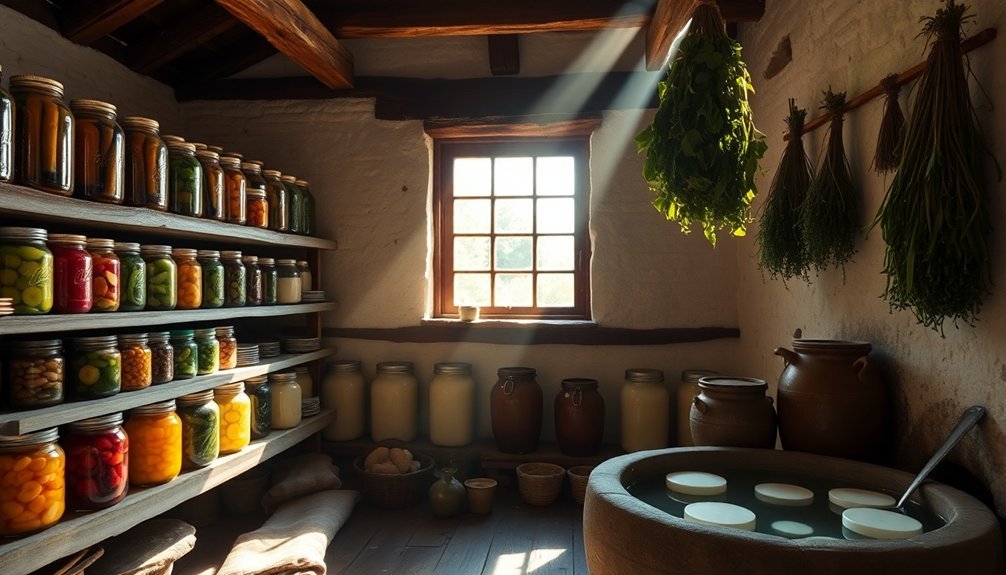



Leave a Reply